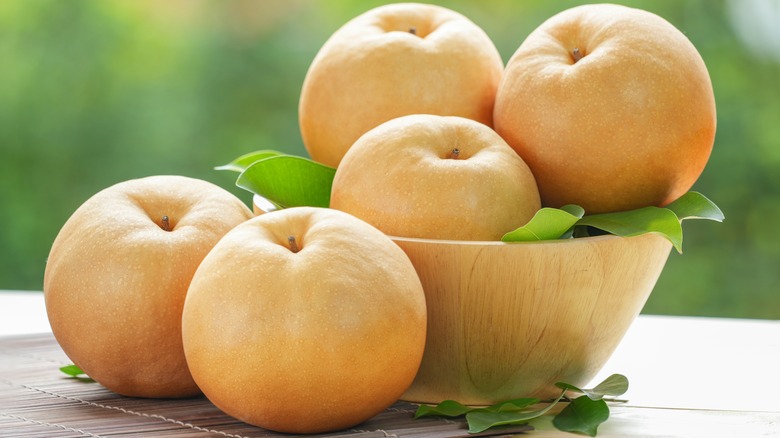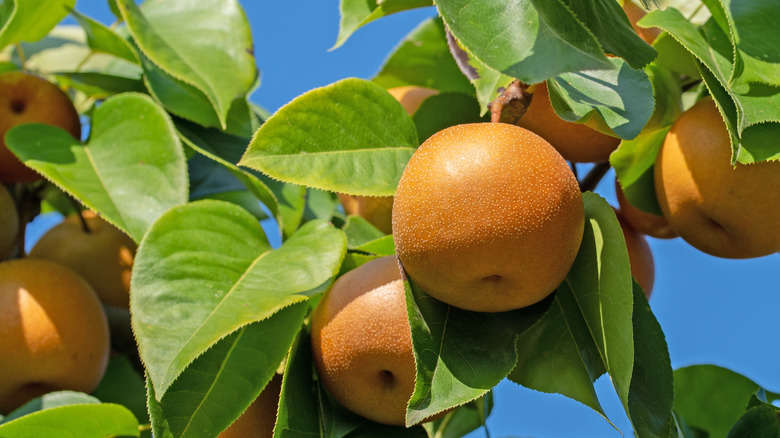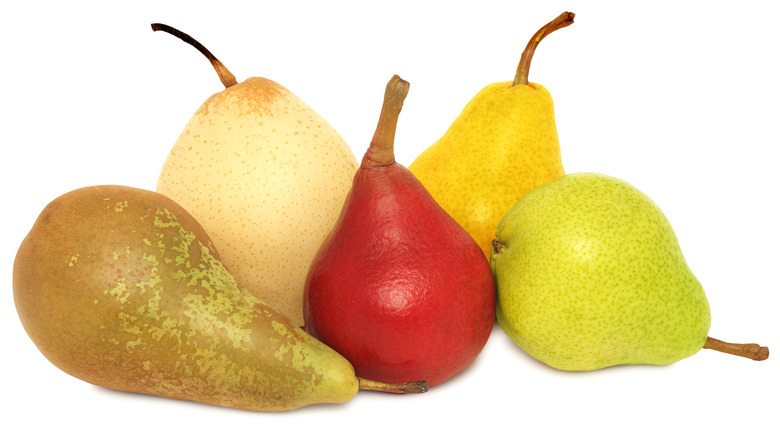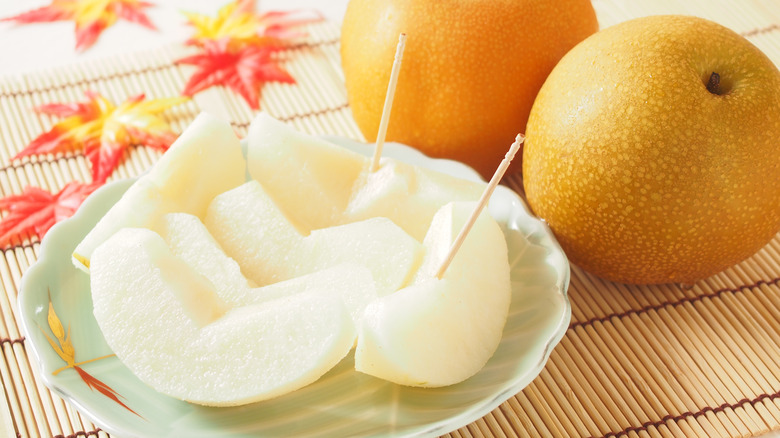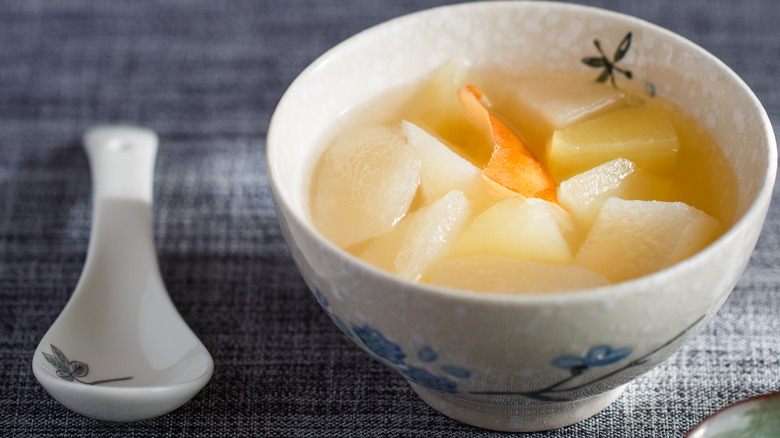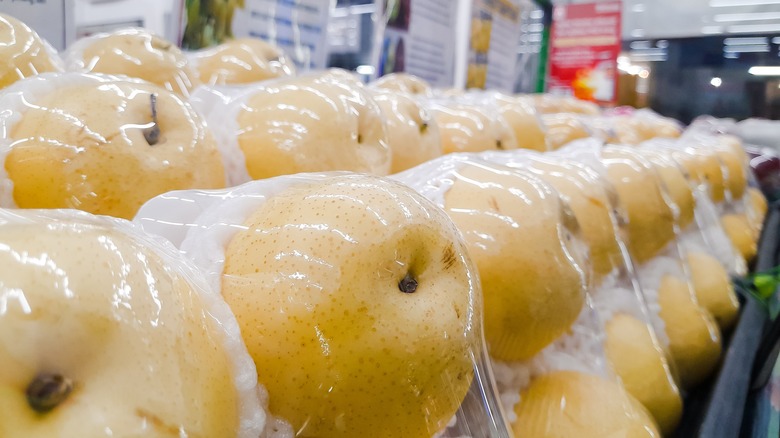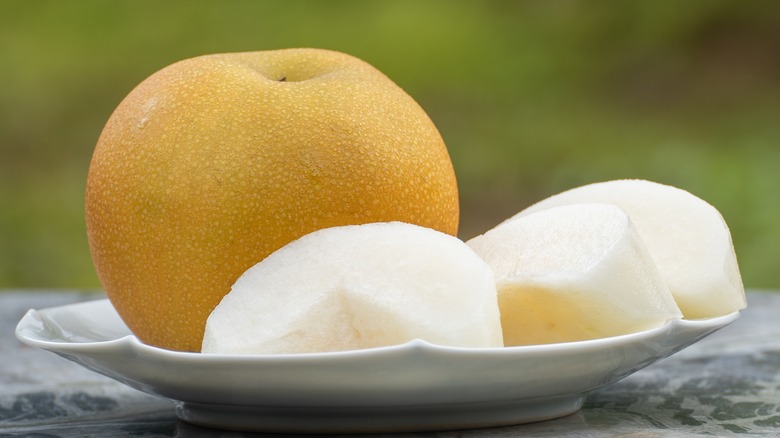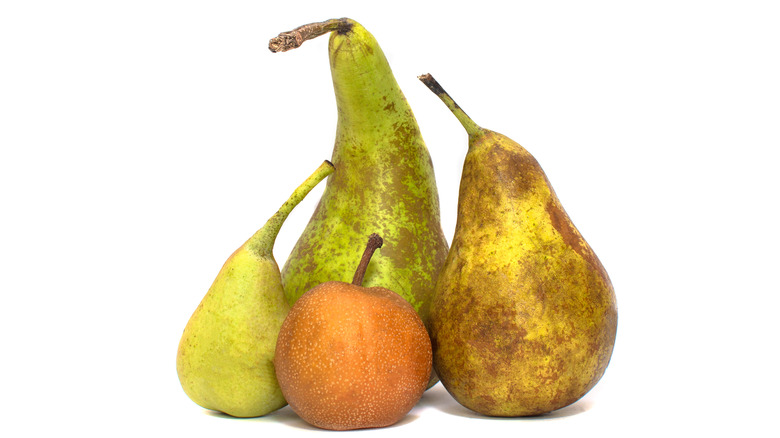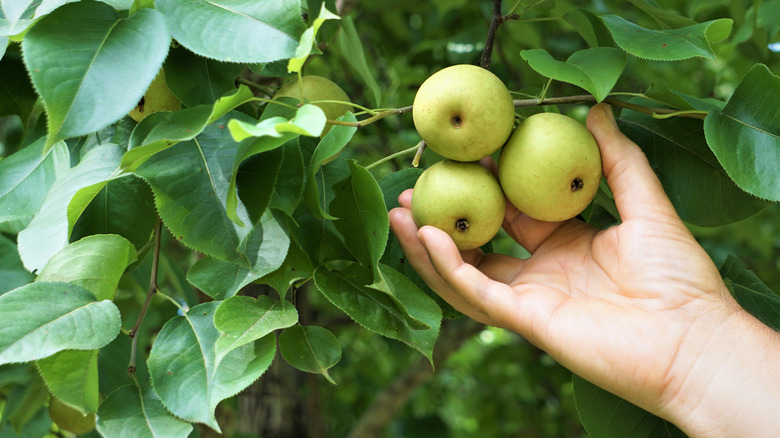What Are Asian Pears And Why Are They So Expensive?
Officially named Pyrus pyrifolia, Asian pears are part of a rose family native to Asia, according to the North Carolina Plant Toolbox. The fruits are often presented as a gift or communally enjoyed within a family setting (via Global Biodiversity Information Facility). Unless you have a tree growing in your yard, these pears can be pricey, which makes it that much more of a treat to receive them in a gift basket. However, the value of the fruit is not only monetary but also regards its symbolic meaning.
According to USA Pears, pears were a sign of prosperity and immortality in ancient Chinese traditions, while Korean folklore purported that the fruit was a source of health, wisdom, and fertility for women. Today, pears continue to symbolize comfort and affection among Chinese people. Asian pears are a fascinating, delicate fruit that fruit lovers will enjoy. If ever you're not up to sharing your bounty, you can always follow Chinese custom, which discourages sharing the fruit as it will cause a split in relationships.
Origins of Asian pears
Otherwise known as Nashi or Li, Asian pears are said to have originated in China and Japan more than 3,000 years ago, per Food Print. The Japanese variety, Nashi, is not only well-suited to warmer climates but also appears rounder, similar to an apple. On the other hand, Chinese Li can often be found in colder climates and have a similar shape to European pears.
For avid home gardeners, there are nine variants that are particularly great for growing, according to Gardener's Path. These are called 20th Century, Chojuro, Drippin' Honey, Hosui, Kosui, Niitaka, Olympic Giant, Shinseiki, and Yoinashi. Mild flavor and textural variations distinguish the different types.
While Asian pears became increasingly popular in American markets during the 1980s, they were first introduced to Queens, New York, in 1820. By the time the Gold Rush rolled around a few decades later, Asian immigrants — who often planted them in their own gardens — introduced Asian pears to the West Coast. At this time, the Asian pear plant was mostly considered to be ornamental, largely due to European settlers' unfamiliarity with the texture. However, once the settlers learned how resistant Asian pear plants were to certain crop diseases, they started to plant them along with European varieties in order to strengthen their resistance too. Today, Asian pears can be found in Korea, Australia, Chile, Italy, and New Zealand, among other countries (via Cooking Chew).
Asian pears vs European pears
According to Gardening Know How, there are three pear varieties under which the other types fall. These include Asian, European (common in North American grocery stores), and a hybrid of the two. While Nashi has a distinct shape, it is differentiated even further based on the texture and color of its skin; those with smooth skin are usually green or greenish-yellow, and those with rougher skin tend to be various shades of copper (via Auburn University).
Regardless of whether or not Asian pears resemble European pears (as the Li variant does), one of the most distinct differences between the two types is the texture. Whereas European pears are soft and creamy when ripe, Asian pears are firm and crisp. Per Cooking Chew, Asian pears are also usually left to ripen on the tree, while European pears are harvested and then left to ripen in storage. Hybrids are ripened much like European pear, however, unlike both varieties which can be eaten fresh, hybrids are more often used for cooking or as preserves.
What do Asian pears taste like?
If you're a fan of European pears, you're probably drawn to the subtle balance of tart and sweet flavors and creamier texture. Asian pears on the hand, are typically sweet with an aromatic quality. According to Speciality Produce, once Asian pears are ripe, the flesh has a discreet grainy feel against your palate, while the core is fibrous and peppered with tiny blackish-brownish seeds.
Moreover, Asian pears have a distinct scent, and in addition to all that sweetness, you might notice some floral notes as you chew on all that goodness. Different variants still have distinct features that set them apart from others. For instance, while Shinseiki pears are only mildly sweet, Niitaka is one of the sweetest Asian pears. 20th Century pears are known for being especially juicy, while Hosui pears (which translates to "much water") are so sweet they are often regarded as a dessert fruit (via Lymano Orchards). Chojuro, Ichiban, Yoinashi, and Yongi all contain a butterscotch taste, with varying notes that span toffee-apple to rum flavors (via The Seattle Times).
How to cook with Asian pears
Before we elaborate, it's utterly important to note that just because you can do something, it doesn't mean you actually should. This is especially the case with Asian pears. While European pears may be more amenable to cooked and baked dishes — whether it's being incorporated into stuffing and sauces for meat dishes or in desserts like caramelized pear tarts, pies, or cake — Asian pears are not necessarily well-suited for these preparations.
Per Food Print, Asian pear fruit can be used in marinades for Korean BBQ, on sandwiches, or served as a component of cheese platters. It can also be added to Hawaiian poke and salads. Ultimately, it's best used in raw dishes as cooking compromises both its texture and juicy sweetness.
David Hagedorn from The Washington Post will attest to this: After incorporating Asian pears into a marinade, salad, and gratin, his conclusion was clear. "Unless you're cooking Asian pears to death and concentrating their flavor, as in a jam, it's not worth the effort. The fruit's subtle, haunting flavor disappears and its effect, like its texture, becomes uninteresting."
Where to buy Asian pears
According to The Seattle Times, unlike most grocers that offer a single type of Asian pear, one can shop up to a dozen different variants at the Rockridge Country Market in Enumclaw, Washington. Among these are milder types like 20th Century, Hosui, Shinseiki, and Shinko; sweeter ones such as Korean Giant, Yakumo, and Kikusui; and richly flavored Chojuro, Ichiban, Yoinashi, and Yongi pears.
Per Best of Korea, in 2002 Target was selling a three-pack format of Asian pears for about $5, while specialty grocers like Whole Foods sold them at about $3.49 for a single fruit. Outside of chain stores like Target and Whole Foods, Asian pears can usually be found at Asian or Korean food markets; in fact, you probably want to look here first if you have any nearby. If you don't have access to a grocer that stocks Asian pears, online stores like Melissa's offer a delivery service across the country.
Nutritional information about Asian pears
When it comes to nutritional value, Asian pears shine with regard to their fiber content. According to Livestrong, some types of Asian pears boast up to 10 grams of fiber in a single fruit, which is about a third of the recommended daily intake for adults. Fiber, especially the soluble kind, is helpful for lowering cholesterol, maintaining blood sugar, supporting heart health, and keeping you full for longer.
Asian pears also contain high levels of magnesium. According to Healthline, even though the mineral is exceptionally important for optimal body and brain functioning, about half of the U.S. adult population is consuming less than the recommended daily intake. Magnesium is involved in hundreds of biochemical reactions within the body, supports bone and heart health, and can improve symptoms of PMS, anxiety, and depression.
Additionally, per Nourish by WebMD, Asian pears contain significant amounts of copper, folic acid, potassium, and vitamins C and K. Folic acid, which assists the body in the cultivation of new cells, is especially valuable during pregnancy. Potassium assists processes associated with a healthy heartbeat, and it supports kidney and nerve function. Meanwhile, vitamins C contains antioxidants that may aid in the prevention of certain types of cancer, while vitamin K maintains the blood's ability to clot effectively.
Other varieties of Asian pears
There are many different Asian pears, but according to the UC Davis Fruit & Nut Research & Information Center, most variants can be classified under one of three distinct types. Those that are round or flat with varying shades of green and yellow skin, round and flat pears with bronze skin, and teardrop pears with either green or russet skin.
In Japan, a popular variety is the 20th Century, which was hybridized during the early 1900s around the same time as the Chojuro pear (via Butter 'n Thyme). Drippin' Honey Asian pears were also hybridized in Japan several decades later. Other non-hybrid varieties that are exceptionally popular in Japan include Shinseiki, Hosui, and Kosui pears.
Ya pears from northern China — also known as Ya Li — resemble European pears in texture and taste and look like apples. There are several common sub-variants of Ya pears; Red Ya are the juiciest among them, followed by green and white Ya. Texturally, brown Ya pears are quite firm, while yellow Ya pears are the crispiest of all the variants. Other types of Asian pears that are typical include the Olympic Giant, Shinko, Yoinashi, Shinseiki pears, Ichiban, and Yakumo, among others.
Why are they so expensive?
When all is said and done, why are Asian pears so much more expensive than European pears and other fruits in general? Ultimately, it comes down to the cultivation processes. According to North Star Orchard, Asian pears require more labor throughout the growing cycle. First, the variant planted must correspond with the climate of the region. Since Asian pear plants cannot self-fertile, they must be planted close to another Asian pear plant in order to cross-pollinate (Rain Tree Nursery).
The location in which they are planted is vitally important as the trees need at least eight hours daily of direct sunlight at the start of summer. Without this exposure to sunlight, the growth of new flower buds will not occur, which means no fruit. Another crucial part of cultivating Asian pears is fruit thinning — this is where it gets especially labor intensive. Because the plants mature earlier than other fruit plants, they produce an inordinate amount of fruit, which needs to be thinned. A general rule of thumb is to reduce clusters of up to three pears to one, and only leave two in areas where there are more than four pears. If this is not meticulously done, a single tree will end up with hundreds of pears that cannot properly ripen.
